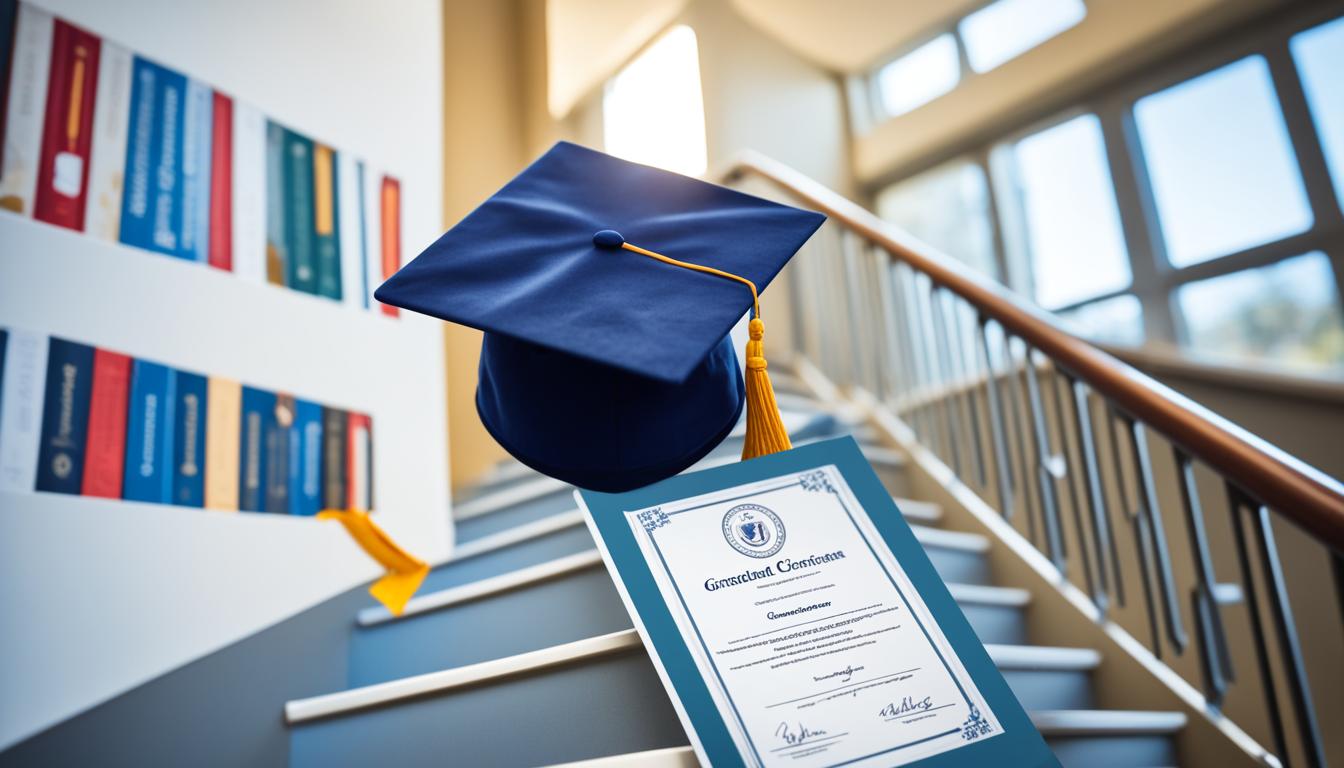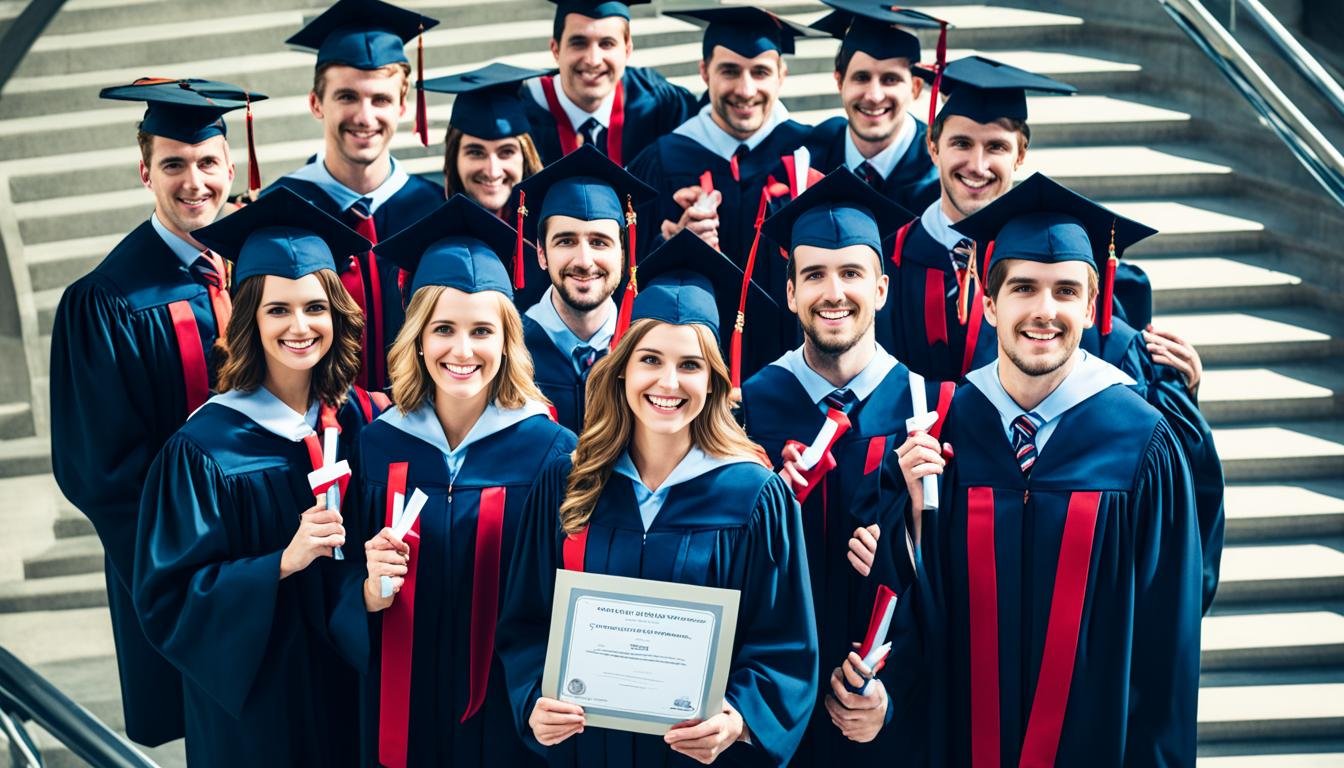Did you know that Moroccan students who implement effective strategies for navigating higher education are more likely to achieve academic success?
Higher education can be a challenging journey, but with the right tools and approaches, students from Morocco and around the world can overcome obstacles, achieve their goals, and thrive in their academic pursuits. In this article, we will explore the strategies and opportunities available to Moroccan students for success in higher education.
Key Takeaways:
- Implementing effective strategies is crucial for Moroccan students to navigate and succeed in higher education.
- Partnerships between universities, such as the collaboration between the University of Dallas and Al Akhawayn University, provide valuable opportunities for students.
- Overcoming academic challenges and financial barriers can be achieved through proper planning and leveraging available resources.
- A multilingual and language-rich classroom environment supports the unique needs of multilingual learners and enhances their academic journey.
- By embracing translanguaging, incorporating students’ funds of knowledge, and activating language games and playful learning, educators can create inclusive and empowering learning environments that promote higher education success.
The Importance of Education in Aouam’s Success
Mohammed Aouam, a native of Morocco, embarked on a remarkable journey to success when he arrived in the United States with limited resources but an unwavering determination. Recognizing the transformative power of education, Aouam set his sights on pursuing a Master’s degree in cybersecurity at the prestigious University of Dallas.
With a thirst for knowledge and a passion for his field, Aouam’s dedication to his studies propelled him to new heights. Through rigorous academic pursuits, he honed his expertise in cybersecurity, acquiring the skills needed to thrive in an increasingly digital world.
As Aouam’s educational journey unfolded, doors began to open for him. Armed with his academic achievements and knowledge, he secured a position in the dynamic field of cybersecurity—a testament to the immense value of education in his personal and professional success.
Today, Mohammed Aouam’s story serves as an inspiration to countless aspiring students, showcasing the transformative impact of education. His journey highlights the vital role that education plays in unlocking opportunities and empowering individuals to achieve their goals.
The Partnership Between University of Dallas and Al Akhawayn University
The University of Dallas and Al Akhawayn University have joined forces through a formal collaboration that aims to foster educational partnerships and promote knowledge sharing in the field of cybersecurity. This groundbreaking partnership signifies the importance of international collaborations between universities and the immense opportunities they create for students.
By bringing together the academic resources and expertise of both institutions, this collaboration seeks to enhance the business landscape in Morocco and contribute to the advancement of cybersecurity practices. Through joint research projects, exchange programs, and collaborative initiatives, students and faculty members from both universities will have the chance to engage in innovative academic endeavors that address the evolving challenges and demands of cybersecurity.
This partnership between the University of Dallas and Al Akhawayn University exemplifies the commitment of both institutions to nurturing the intellectual growth and professional development of their students. By leveraging each other’s strengths and knowledge, these universities can provide a comprehensive educational experience that prepares students for successful careers in cybersecurity.
Through this collaboration, students will gain access to diverse perspectives, cultural experiences, and cutting-edge research opportunities, ensuring they are equipped with the skills and expertise needed to excel in the field. This partnership also paves the way for future university collaborations and serves as a remarkable example of the transformative power of educational partnerships.
Universities working together create a dynamic and enriching academic environment, fostering the growth of individuals and society as a whole. The partnership between the University of Dallas and Al Akhawayn University represents a significant step towards advancing higher education and strengthening the cybersecurity landscape in Morocco.
Overcoming Academic Challenges in Higher Education
Higher education can present a range of academic challenges that may hinder your success. The journey can be filled with academic rigor, complex lectures, and voluminous assignments. However, with the right strategies and mindset, you can overcome these obstacles and thrive in your higher education pursuits.
Strategies for Success
Implementing effective strategies can greatly enhance your academic performance. Consider the following strategies:
- Create a study schedule:
- Seek guidance from professors:
- Utilize online resources:
Developing a study schedule helps you stay organized and manage your time effectively. Allocate specific time slots for each subject or assignment, ensuring that you create a balanced approach to your studies.
Don’t hesitate to reach out to your professors when you encounter difficulties. They are there to support you and provide clarification on complex topics. Take advantage of office hours or schedule appointments to discuss any challenges you may be facing.
In today’s digital age, there are numerous online resources available to supplement your learning experience. Take advantage of academic websites, online tutorials, and educational videos to deepen your understanding of challenging concepts.
By implementing these strategies, you can effectively navigate the academic challenges of higher education and position yourself for success. Remember to stay focused, motivated, and proactive in your approach to learning.

Affordability of Tertiary Education
When it comes to pursuing higher education, financial barriers often pose significant challenges. Many students find themselves burdened by the high costs of tuition, making it difficult to access the education they desire. However, the University of Dallas is committed to breaking down these financial barriers and ensuring that high-quality education remains affordable and accessible to all who aspire to learn.
Through strategic partnerships and scholarship initiatives like the Unicaf scholarship program, the University of Dallas aims to reduce tuition costs and provide students with the opportunity to fulfill their educational goals without the burden of excessive financial strain. By removing these financial obstacles, the university empowers learners to pursue their passions and unlock their full potential.
Partnerships for Affordable Education
Collaborating with reputable institutions, the University of Dallas offers students the advantage of an affordable education. These partnerships enable students to access a diverse range of courses and programs, ensuring that they receive a comprehensive and high-quality education without excessive financial burdens. By pooling resources and expertise, these partnerships make education more accessible and affordable.
The Unicaf Scholarship Program
The Unicaf scholarship program is another significant avenue through which the University of Dallas supports affordable education. This program is designed to provide financial assistance to deserving students, helping them overcome the financial barriers that often come with pursuing higher education.
Through the Unicaf scholarship program, eligible students can receive financial support that significantly reduces their tuition costs. This financial aid allows students to focus on their studies, engage in extracurricular activities, and make the most of their university experience, without the constant worry of accumulating debt or struggling to afford their education.
- Enables talented students to access high-quality education
- Reduces the burden of tuition costs
- Empowers students to fulfill their educational aspirations
- Opportunity to focus on academic success without financial strain
The University of Dallas is dedicated to ensuring that financial constraints do not limit students’ dreams and aspirations. By providing affordable education through partnerships and scholarship programs like Unicaf, the University of Dallas is committed to making higher education accessible to all, regardless of their financial circumstances.
Skill-Building Opportunities for Academic Success
Unicaf, a trailblazer in online education, offers valuable support to students on their academic journey. With personalized academic mentorship, flexible payment plans, and a commitment to reducing financial barriers, Unicaf empowers you to excel in your studies and achieve your academic goals.
Unicaf understands that skill development is key to academic growth. That’s why they provide a range of educational resources to enhance your learning experience. Through their innovative online platform, you have access to interactive modules, engaging lectures, and practical assignments that align with your field of study.
One of the unique advantages Unicaf offers is personalized academic mentorship. You’ll be paired with experienced mentors who provide guidance and support tailored to your individual needs. Whether you need help with coursework, exam preparation, or career advice, their mentors are there to assist you every step of the way.
Unicaf also understands that financial constraints should not hinder your academic aspirations. They offer flexible payment plans, making education more accessible and affordable. You can choose a payment schedule that suits your budget, ensuring that you can pursue your studies without financial stress.
The image above represents the opportunities for skill development that Unicaf provides. With their comprehensive support and resources, you can enhance your academic skills and knowledge, preparing yourself for future success.
Unicaf’s commitment to reducing financial barriers is evident through their scholarship programs. They offer various scholarships to eligible students, enabling them to pursue higher education with reduced tuition costs. These scholarships open doors for students who may not have had the financial means to further their education otherwise.
By choosing Unicaf, you are not just enrolling in an online program; you are joining a supportive community dedicated to your academic growth. Unicaf’s commitment to your success extends beyond the virtual classroom, providing the resources and support you need to excel in your studies and achieve your goals.
Next, in Section 7, we will explore the importance of creating a multilingual and language-rich classroom environment to support the unique needs of multilingual learners.
Building a Multilingual and Language-Rich Classroom Environment
Creating a multilingual classroom space is essential for supporting the unique needs of multilingual learners. By incorporating strategies that promote multilingualism, educators can create language-rich environments rich in cultural diversity and academic growth.
1. Incorporating Multilingual Materials
One way to foster a language-rich classroom is by incorporating multilingual materials. Provide books, posters, and educational resources in multiple languages, allowing students to engage with content in their native language and promoting cross-cultural understanding.
2. Encouraging Translanguaging
Encouraging translanguaging, the use of multiple languages in communication, can support multilingual learners’ language development. Embrace linguistic diversity by allowing students to use their home language alongside English, fostering a collaborative and inclusive learning environment.
3. Activating Students’ Cultural Assets
Every student brings their unique cultural and linguistic assets to the classroom. Teachers can tap into these assets by incorporating students’ cultural practices, stories, and experiences into the curriculum. By valuing and activating their cultural backgrounds, educators empower multilingual learners, fostering a sense of pride and belonging.
To illustrate, imagine a classroom adorned with multilingual posters showcasing diverse cultures and languages. Students engage in conversations that seamlessly flow between different languages, celebrating their linguistic diversity. This real-world exposure to multilingualism creates an immersive and inclusive language-rich environment.
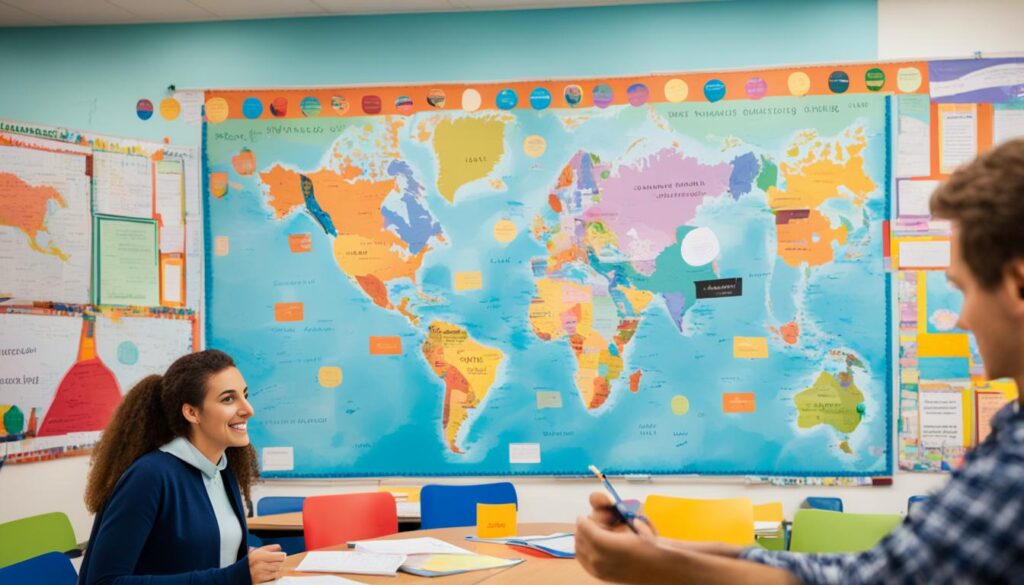
By implementing these strategies, educators can nurture a multilingual and language-rich classroom environment that supports and empowers multilingual learners. Not only will students excel academically, but they will also develop a strong sense of cultural identity and become effective communicators in a globalized world.
The Cognitive and Linguistic Benefits of Multilingualism
Being multilingual offers a range of cognitive advantages that contribute to academic success and overall cognitive development. Research shows that individuals who speak multiple languages possess superior task-switching abilities, enhanced cognitive control, and increased adaptability.
Multilingualism stimulates the brain, requiring efficient mental processing to switch between languages and select the appropriate words and grammar rules for each context. This constant mental exercise strengthens cognitive skills and improves executive functions like attention and problem-solving.
Task-Switching Abilities
Bilingual and multilingual individuals have developed the ability to shift between different languages effortlessly. This skill translates beyond language use, enabling them to switch between tasks more efficiently and adapt to new situations with ease. The cognitive flexibility gained from multilingualism becomes an asset in diverse academic settings and real-life scenarios.
Cognitive Control
Speaking multiple languages requires the constant inhibition of non-relevant languages. This practice strengthens cognitive control, which refers to the ability to focus attention, ignore distractions, and switch between mental tasks. Multilingual individuals exhibit higher levels of cognitive control, leading to improved concentration, reduced impulsivity, and increased self-regulation.
Adaptability
The linguistic diversity that comes with multilingualism fosters adaptability and open-mindedness. Multilingual individuals develop a broader perspective, as they can perceive the world through different linguistic and cultural lenses. This adaptability makes them more receptive to new ideas, cultures, and ways of thinking, enhancing their creativity and problem-solving abilities.
Furthermore, research supports the positive correlation between multilingualism and academic success. Multilingual learners often outperform monolingual peers in various academic areas. Their enhanced cognitive skills, linguistic flexibility, and multicultural understanding enable them to approach learning with a unique advantage. Multilingualism offers them a solid foundation for acquiring additional languages, further expanding their linguistic and cognitive abilities.
Embracing multilingualism in education unlocks numerous benefits for students, both academically and cognitively. By providing multilingual opportunities and creating inclusive language-rich environments, educators can empower students to reach their full potential and thrive in an increasingly interconnected world.
Social and Cultural Benefits of Multilingualism
Multilingualism offers numerous social and cultural benefits that contribute to personal growth and a sense of belonging. By embracing multiple languages, individuals develop valuable social and emotional learning skills and foster a strong cultural identity. Additionally, multilingualism promotes cultural appreciation and intercultural understanding, contributing to a more inclusive and diverse society.
Research shows that multilingual learners often outperform their monolingual peers in social and emotional measures. Speaking multiple languages allows individuals to navigate diverse social contexts with ease, fostering effective communication and building strong relationships. Multilingual individuals exhibit a greater understanding and empathy towards different cultures, leading to increased cultural competence and sensitivity.
Furthermore, multilingualism provides individuals with opportunities to connect with various communities and cultures, enabling them to form deeper connections and establish a sense of belonging. By being able to communicate in multiple languages, individuals can engage with diverse cultural practices, traditions, and perspectives, strengthening their cultural identity and enriching their worldview.
Cultural Competence and Multilingual Identity
- Enhances cultural sensitivity and understanding
- Encourages respect for diverse cultural practices
- Fosters a sense of belonging and acceptance
- Promotes intercultural communication and collaboration
- Broadens perspectives and promotes open-mindedness
Developing cultural competence through multilingualism allows individuals to embrace diversity and engage in meaningful cross-cultural interactions. It enables them to appreciate the unique qualities and contributions of different cultures, fostering a more inclusive and harmonious society.
By promoting social benefits and cultural competence, multilingualism plays a vital role in shaping individuals’ experiences and interactions within their communities. Embracing multilingualism not only enhances personal growth but also contributes to a more interconnected and culturally rich world.
Creating Multilingual Classroom Spaces
Creating a multilingual classroom is an essential step towards embracing diversity and fostering an inclusive learning environment. By setting up a multilingual classroom, you not only support language development but also promote cultural appreciation and understanding.
To ensure a multilingual classroom setup, start by decorating the physical space with multilingual materials. Hang posters, charts, and bulletin boards that display vocabulary, phrases, and greetings in different languages. This visual representation of diverse languages will not only create an inviting atmosphere but also encourage curiosity and exploration.
Another way to enhance the language-rich environment is by incorporating diverse cultural artifacts. Display items such as traditional clothing, artwork, or musical instruments from various cultures. These artifacts can spark students’ interest and provide opportunities for learning about different traditions and customs.
Encouraging conversations in both English and students’ home languages is another crucial aspect of a multilingual classroom. Embrace linguistic diversity by allowing students to communicate and express themselves in their native languages. This practice not only validates their linguistic identities but also promotes confidence and active participation.
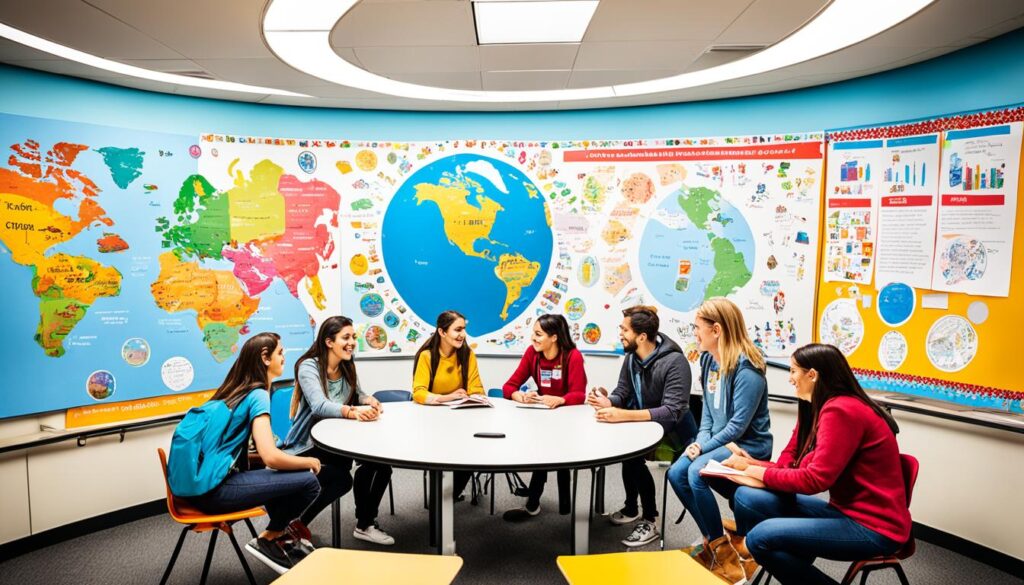
Furthermore, providing multilingual books and resources is vital for creating a language-rich learning environment. Incorporating books, magazines, and online resources in various languages exposes students to different literary traditions and broadens their understanding of the world. It also offers opportunities for language practice and strengthens reading skills.
Incorporating a multilingual classroom setup and embracing diversity goes beyond language learning. It nurtures cultural competence, celebrates individual identities, and prepares students for success in an interconnected world.
Embracing Translanguaging in the Classroom
Translanguaging, the practice of using multiple languages in communication, can significantly support the language development of multilingual learners. By embracing translanguaging strategies, educators can create a language-rich environment that fosters language flow and leverages classmates’ language skills.
One effective way to facilitate translanguaging is by allowing language mixing in the classroom. Encourage students to freely switch between languages, as this promotes language development and increases their confidence in expressing themselves. By embracing the diverse linguistic repertoire of your students, you create an inclusive space where language is celebrated.
Online translation tools can also be valuable resources in supporting translanguaging. These tools can help students overcome language barriers and actively engage in discussions. Encourage students to use translation tools as a means of understanding unfamiliar words or phrases while maintaining the flow of their thoughts in their preferred language. This empowers them to fully participate in classroom activities, regardless of their language proficiency.
Leveraging classmates’ language skills is another effective strategy in embracing translanguaging. Encourage students to collaborate and assist each other by tapping into their individual language strengths. This not only fosters a sense of community but also expands their language repertoire as they learn from one another.
By creating an environment that embraces translanguaging, you promote language flow and provide opportunities for multilingual learners to use their full linguistic repertoire. It also acknowledges the linguistic assets that each student brings to the classroom, creating a culturally inclusive learning experience.
Activating Funds of Knowledge in Multilingual Education
When it comes to multilingual education, the diverse range of cultural and linguistic backgrounds that students bring to the classroom should be seen as valuable assets. As an educator, you have the opportunity to tap into their funds of knowledge, unleashing the power of their cultural capital to enhance their learning experience.
One way to activate funds of knowledge is by incorporating students’ cultural practices into the curriculum. By integrating culturally relevant content, you create a more inclusive and engaging learning environment. This not only validates students’ cultural identities but also allows them to see the connections between their home language and English, fostering a deeper understanding of both.
Encouraging students to share their own background knowledge and experiences is another effective strategy. Providing opportunities for students to contribute their unique perspectives during class discussions can enrich the learning process for everyone. By empowering students to use their existing knowledge as a foundation, you create a sense of ownership and motivation in their educational journey.
Additionally, cultivating a collaborative and supportive classroom environment is crucial. By leveraging the linguistic diversity of your students, you can encourage linguistic exchanges that promote language development and cultural understanding. Pairing students with different language backgrounds for group activities or projects allows them to learn from one another and build upon their strengths.
Incorporating students’ funds of knowledge in multilingual education not only enhances their academic achievement but also nurtures their cultural identity and self-confidence. By creating a classroom that values and activates their cultural capital, you empower students to embrace their unique backgrounds, fostering a sense of belonging and promoting a positive educational experience.
Incorporating Language Games and Playful Learning
Language games and wordplay activities are powerful tools for engaging multilingual learners and promoting language development in a playful manner. These interactive activities not only make learning enjoyable but also strengthen language skills, build vocabulary, and enhance concept knowledge.
Teachers can incorporate a variety of language games that target listening, speaking, reading, and writing skills. For example, “Word Chain” challenges students to take turns adding a word that begins with the last letter of the previous word, creating a chain of interconnected words. This game not only encourages creativity but also improves vocabulary and spelling proficiency.
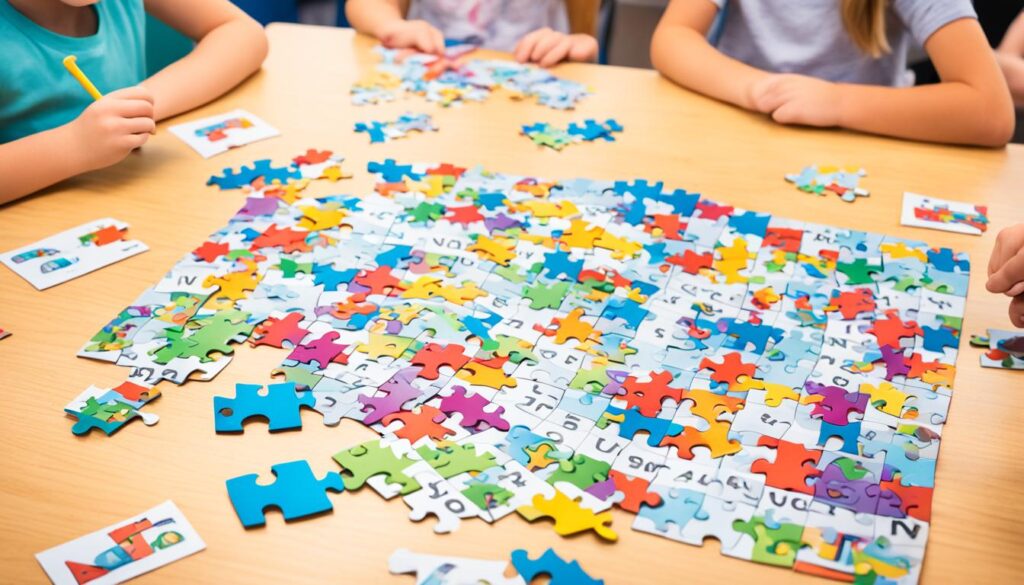
Another fun activity is “Sentence Scramble,” where students work together to rearrange jumbled words into coherent sentences. This exercise improves sentence structure, grammar, and reading comprehension. Additionally, incorporating tongue twisters or riddles can promote critical thinking, pronunciation, and problem-solving skills.
Language games can be adapted for different proficiency levels and linguistic backgrounds, ensuring inclusivity and active participation. By infusing playful learning into the classroom, teachers create an engaging environment that stimulates language acquisition and fosters a love for language learning.
Making Connections Between English and Home Language
Helping students make connections between English and their home language is crucial for reinforcing their cultural identity and empowering them to utilize their entire linguistic repertoire. By supporting this process, educators can create an inclusive and nurturing environment that fosters language connections, home language support, and bilingual learning.
Engaging students in discussions that explore the similarities and differences between English and their home language can facilitate a deeper understanding of language structures and vocabulary. Encourage students to share and compare phrases, idioms, or expressions, allowing them to appreciate the rich linguistic diversity within the classroom.
Translation tools can also be valuable resources in bridging the gap between languages. Encourage students to use digital dictionaries or translation apps to help them navigate unfamiliar words or phrases. Emphasize the importance of using these tools as a means of learning and expanding their language skills, rather than relying on them exclusively.
Providing opportunities for creative language use is another effective strategy for making connections between English and students’ home language. Encourage students to express themselves through writing, storytelling, or even presenting information using both languages. This not only enhances their language proficiency but also fosters a sense of ownership and pride in their bilingual abilities.
Remember, promoting language connections, home language support, and bilingual learning contributes to the overall academic success and emotional well-being of multilingual learners. By embracing and celebrating the diversity of languages within your classroom, you create a space where students can thrive and develop their language skills to their fullest potential.
Supporting Academic Success Through Language-Rich Environments
Creating language-rich environments is crucial for promoting academic success by fostering academic language development, enhancing English proficiency, and strengthening academic skills. As an educator, you have the power to cultivate a language-rich classroom that nurtures language growth and supports students in their academic journey.
One key strategy to enhance language development is by incorporating authentic language use in your lessons. Provide opportunities for students to engage in meaningful conversations, debates, and presentations, encouraging them to express their ideas and thoughts in English. By engaging in real-world language experiences, students can sharpen their language skills and build confidence in using academic language.
Additionally, utilizing translation tools can be a valuable asset in a language-rich classroom. These tools can support students in understanding and expressing complex ideas, bridging gaps in their English proficiency. By incorporating translation tools, such as bilingual dictionaries or language translation apps, you empower students to access information and communicate effectively.
Furthermore, activating students’ funds of knowledge can be a powerful way to support academic success. By recognizing and valuing students’ cultural and linguistic backgrounds, you create a more inclusive learning environment. Encourage students to draw upon their own cultural experiences, incorporating their home language and cultural practices into discussions and assignments. This not only enhances their language skills but also fosters a sense of belonging and pride in their identity.
The Benefits of Language-Rich Environments
- Promotes academic language development
- Enhances English proficiency
- Strengthens academic skills
- Fosters a sense of cultural identity
- Supports students’ funds of knowledge
- Creates an inclusive and empowering learning environment
By embracing language-rich environments in your classroom, you pave the way for academic success. As students engage in authentic language use, utilize translation tools, and activate their funds of knowledge, they develop the necessary language skills and academic proficiency to excel in their studies. Embracing and promoting language-rich environments is a transformative way to support your students’ academic endeavors.
Achieving Academic Success Through Language
Language plays a pivotal role in academic success. By creating language-rich classrooms that prioritize academic language development, English proficiency, and academic support strategies, educators can empower students to thrive academically and reach their full potential.
Conclusion
The Moroccan Academic Odyssey: Strategies for Higher Education Success underscores the significance of implementing key strategies to support multilingual learners in their higher education journey. By creating multilingual classroom spaces, educators can foster inclusive and empowering learning environments that celebrate linguistic and cultural diversity. Embracing translanguaging, the use of multiple languages, encourages language development and enhances students’ language skills.
In addition, activating students’ cultural and linguistic assets leverages their unique backgrounds and experiences, enriching the learning process. These strategies collectively contribute to providing the necessary support for multilingual learners to navigate higher education successfully. By implementing these approaches, educators can help students achieve academic success and empower them to reach their full potential.
In summary, the Moroccan Academic Odyssey highlights the importance of creating multilingual classroom spaces, embracing translanguaging, and activating students’ cultural and linguistic assets. These strategies play a vital role in fostering inclusive and empowering learning environments that promote higher education success. By incorporating these approaches, educators can equip multilingual learners with the necessary tools to navigate and excel in their educational journeys.
FAQ
Q: What is the significance of education in Mohammed Aouam’s success story?
A: Mohammed Aouam, a Moroccan student, recognized the value of education and pursued a Master’s degree in cybersecurity at the University of Dallas. His academic achievements and expertise in the field opened doors for him, leading to a successful career in cybersecurity.
Q: What is the partnership between the University of Dallas and Al Akhawayn University?
A: The University of Dallas and Al Akhawayn University have signed a formal partnership aimed at sharing cybersecurity knowledge and improving businesses in Morocco. This collaboration showcases the importance of international educational partnerships and the opportunities they bring for students.
Q: How can students overcome academic challenges in higher education?
A: Students can overcome academic challenges in higher education by implementing strategies such as creating a study schedule, seeking guidance from professors, and utilizing online resources.
Q: How does the University of Dallas make tertiary education affordable?
A: The University of Dallas, through partnerships and scholarships like the Unicaf scholarship program, aims to make high-quality education more affordable and accessible to students, ensuring that financial constraints do not limit their dreams.
Q: How does Unicaf support students on their academic journey?
A: Unicaf, a trailblazer in online education, offers valuable support to students with personalized academic mentorship, flexible payment plans, and a commitment to reducing financial barriers, empowering students to excel in their studies and achieve their academic goals.
Q: How can you create a multilingual and language-rich classroom environment?
A: Creating a multilingual classroom space includes strategies such as incorporating multilingual materials, encouraging translanguaging, and activating students’ cultural assets to foster a language-rich learning environment.
Q: What are the cognitive and linguistic benefits of multilingualism?
A: Multilingual individuals possess cognitive and linguistic advantages, including better task-switching abilities, cognitive control, and adaptability. Research also indicates that multilingual learners excel academically and have a greater potential for additional language learning.
Q: What are the social and cultural benefits of multilingualism?
A: Multilingualism enhances social and emotional learning skills, fosters a sense of cultural identity, and promotes cultural appreciation. Multilingual learners often fare better than their monolingual peers in social and emotional measures.
Q: How can you create a multilingual classroom space?
A: Setting up a multilingual classroom includes decorating the physical space with multilingual materials, incorporating diverse cultural artifacts, and encouraging conversations in both English and students’ home languages. Providing multilingual books and resources also contributes to a language-rich environment.
Q: How can translanguaging be embraced in the classroom?
A: Teachers can facilitate translanguaging by allowing language mixing, using online translation tools, and encouraging students to draw upon their linguistic repertoire, supporting multilingual learners’ language development.
Q: How can you activate funds of knowledge in multilingual education?
A: Teachers can tap into multilingual students’ funds of knowledge by incorporating their cultural practices, making connections between English and their home language, and empowering them to use their existing knowledge to enhance their learning experience.
Q: How can language games and playful learning be incorporated in the classroom?
A: Language games and wordplay activities can engage multilingual learners, strengthen language skills, and build vocabulary and concept knowledge. Teachers can incorporate listening, speaking, reading, and writing activities that encourage creative wordplay and promote language development.
Q: How can connections between English and the home language be made?
A: Helping students make connections between English and their home language reinforces their cultural identity and enables them to utilize their entire linguistic repertoire. Teachers can support this process through discussions, translation tools, and providing opportunities for creative language use.
Q: How do language-rich environments contribute to academic success?
A: Language-rich environments contribute to academic success by supporting language development, English proficiency, and academic skills. Teachers can foster language-rich classrooms by incorporating authentic language use, using translation tools, and activating students’ funds of knowledge.

